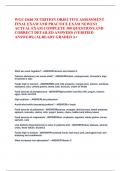WGU D440 NUTRITION OBJECTIVE ASSESSMENT
FINAL EXAM AND PRACTICE EXAM NEWEST
ACTUAL EXAM COMPLETE 300 QUESTIONS AND
CORRECT DETAILED ANSWERS (VERIFIED
ANSWERS) |ALREADY GRADED A+
What two work together? - ANSWERCalcium and vitamin D
Calcium deficiency can cause what? - ANSWERRickets, osteoporosis, chvostek's sign,
trousseau's sign
Foods high in calcium - ANSWERMilk and milk products, orange juice, salmon, sardines,
soybeans, tofu, collard greens, beets, kale, broccoli, cream of wheat
Food sources of phosphorous - ANSWERHigh protein food like milk, yogurt, cheese,
eggs, meat, and fish
High sodium= - ANSWERLow potassium
Avoid what while increasing sodium? - ANSWERk+ foods
Food sources of potassium - ANSWERBananas, oranges, dried prunes, sweet potatoes,
spinach, avocado, raisins, milk, yogurt, beans, clams, halibut and kidney beans
Food sources of magnesium - ANSWERNuts, soybeans, legumes, whole grains, cocoa,
spinach, oats
Low Sodium (Hyponatremia) is seen in patients with - ANSWERKidney disease, adrenal
crisis, heart failure, diuretics
Foods high in sodium - ANSWERProcessed foods, fast food, junk, packaged food, and
dressing and condiments
What increases iron absorption? - ANSWERVitamin C
, Sources of iron - ANSWERLiver, pork, chicken, beef, enriched grains, dark green leafy
veg, oysters, soybeans, tofu, molasses
Food sources for folate vitamin B9 - ANSWERAsparagus, edamame, spinach, orange
juice, chicken and turkey liver, chickpeas, garbanzo beans, legumes, YOGURT, ready to
eat Quaker cereals
Iodine deficiencies are - ANSWERGoiter, cretinism, and hypothyroidism
Sources of iodine - ANSWERSeafood, seaweed, shellfish and table salt
Food sources of zinc - ANSWERSeafood, lobsters, oysters, crabs, meat, yogurt,
soybeans, legumes, whole grains
Vitamin A is for - ANSWERApricots and orange foods. It is retinol for vision
Food sources of vitamin a - ANSWERFish oil, carrots, kale, spinach, sweet potatoes,
yams, pumpkins, melons, apricots, liver, egg yolks, and butter, cream, milk
Vitamin K is for - ANSWERKALE
Vitamin k deficiency is - ANSWERSevere malabsorption disorders like crohns
Sources of vitamin K - ANSWERSpinach, kale, collard greens, turnips, mustard greens
and beets
Vitamin C is - ANSWERSCURVY AND CITRUS FRUITS
Vitamin c increases - ANSWERIron absorption
Vitamin c sources - ANSWERCitrus fruits, oranges, tomatoes, kiwis, berries, lemons,
pineapple, broccoli, yellow and green vegetables, PEPPERS
Vitamin B1 thiamine food sources - ANSWERBread, flour, cereal, rice, pasta, beans and
legumes, hams, pork loin, nuts, yeast
Vitamin B3 niacin who is at risk - ANSWERVegans, alcoholics, pts with crohns disease
Sources of vitamin b3 niacin - ANSWERCows milk, yogurt, beef liver, almond, soybeans
and grains
Vitamin B12 (cobalamin) sources - ANSWERbeef liver, chicken, fish, peanuts, tuna,
wheats, total whole grain cereal, kelloggs cereal
A mechanical soft diet is for - ANSWERPatients who lack teeth
Dysphagia - ANSWERPts who have difficulty chewing and swallowing. Have risk for
nutrient deficiencies also
GERD (low fat diet) - ANSWERLow fat, eat small frequent meals, drink mostly between
meals, sit upright when eating as this is acid reflux.




